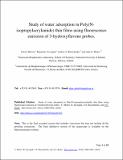Study of water adsorption in PolyN-isopropylacrylamide) thin films using fluorescence emission of 3-hydroxyflavone probes
Date
2010Author
Morris, Cheryl
Szczupak, Boguslaw
Ryder, Alan G.
Metadata
Show full item recordUsage
This item's downloads: 484 (view details)
Cited 14 times in Scopus (view citations)
Recommended Citation
Morris,C.,Szczupak,B.,Klymchenko,A.S.,Ryder,A.G. (2010) 'Study of water adsorption in PolyN-isopropylacrylamide) thin films using fluorescence emission of 3-hydroxyflavone probes'. Macromolecules, 43 (22):9488-9494.
Published Version
Abstract
The noncontact measurement of water uptake in microscale , thermoresponsive poly(N-isopropylacrylamide) thin films is challenging. We assessed the efficacy of three different 3-hydroxyflavone (3-HF)-based fluorophores to monitor water uptake in pNIPAM thin films close to the lower critical solution temperature (LCST) at 25 and 37 °C. These 3-HF fluorophores undergo excited-state intramolecular proton transfer, yielding emission from normal (N*) and tautomeric (T*) excited-state forms. The emission intensity ratio, log(IN*/IT*), and N* band position are environmentally sensitive. Water adsorption in pNIPAM thin films follows a nonlinear, two-phase process: at low relative humidity, the adsorbed water disrupts polymer-fluorophore hydrogen bonding, yielding small changes in log(IN*/IT*) ratios and overall intensity; at higher relative humidity, these intensity parameters (but not fluorescence lifetime) change dramatically, indicating a larger change in local polarity. These probes are thus sensitive indicators of water uptake in pNIPAM.
Description
Journal article


